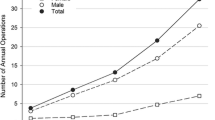Abstract
During 1989, 28 centers of the Association for Academic Research in Vascular Surgery (AURC) reported all cases involving patients with infrarenal abdominal aortic aneurysm (AAA) who reached the operating room alive. In a total series of 1107 procedures, 834 were performed electively. During 1993 and 1994, an effort was made to contact and, if possible re-examine the 794 (95.2%) patients who survived these elective procedures in order to establish survival curves, determine the causes of late death, and ascertain the predictive value for long-term survival of 628 perioperative variables recorded in 1989. Survival curves were calculated using the actuarial and Kaplan-Meier methods and compared with those obtained from national statistical records in a control population matched for age and sex. Variables with potential predictive value for late death were selected by univariate statistical analysis using either the x2 or student t-test. In the group of 794 (92.5%) patients who survived elective AAA repair in 1989, survival rates were 93.9 ± 1.8% at 1 year, 89.5 ± 3.2% at 2 years, 83.5 ± 3.2% at 3 years, 77.6 ± 3.9% at 4 years, and 66.9 ± 10.6% at 5 years. These rates were significantly lower than those observed in the control population. The mean annual death rate from cardiovascular disease was 1.8%, which was higher than in the control population matched for age and sex. Analysis using the Cox proportional risk model showed that the following variables were significant, independent predictors of late death: diameter of aneurysm (p < 0.02), choice of surgical approach in function of general status (p < 0.02), left ventricular insufficiency (p < 0.02), age (p < 0.02), carotid artery occlusion (p < 0.03), use of a surgical approach other than lombotomy (p < 0.04), cardiac arrhythmia (p < 0.04), duration of aortic clamping (p < 0.05), ECG evidence of myocardial ischemia (p < 0.05), abnormality at the upper limit of the aneurysm (p < 0.05), and advanced renal insufficiency (p < 0.05). Life expectancy in patients that undergo successful AAA repair is lower than in the general population. Although death is often unrelated to AAA or the repair procedure, the incidence of morbidity due to cardiovascular disease is higher than in a control population matched for age and sex. These findings suggest that better management of concurrent cardiovascular disease during the perioperative period and long-term follow-up holds the key to improving life expectancy in patients undergoing AAA repair. (Ann Vasc Surg 1997; 11:473–481.)
Similar content being viewed by others
Author information
Authors and Affiliations
About this article
Cite this article
Koskas, F., Kieffer, E. Long-Term Survival after Elective Repair of Infrarenal Abdominal Aortic Aneurysm: Results of a Prospective Multicentric Study. Annals of Vascular Surgery 11, 473–481 (1997). https://doi.org/10.1007/s100169900078
Published:
Issue Date:
DOI: https://doi.org/10.1007/s100169900078




